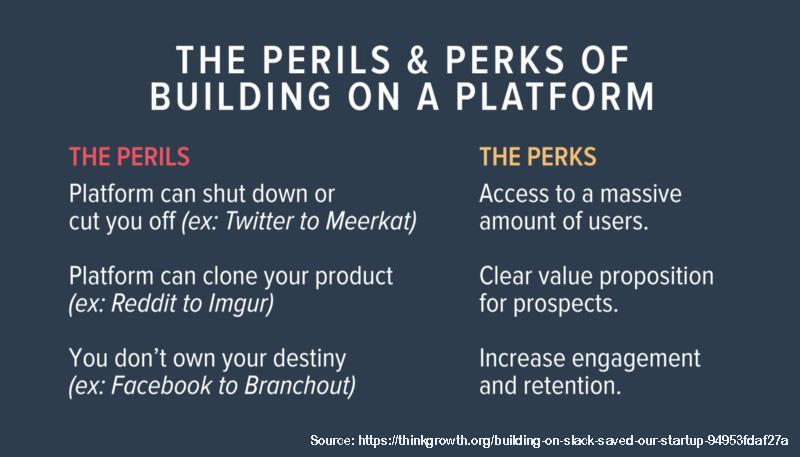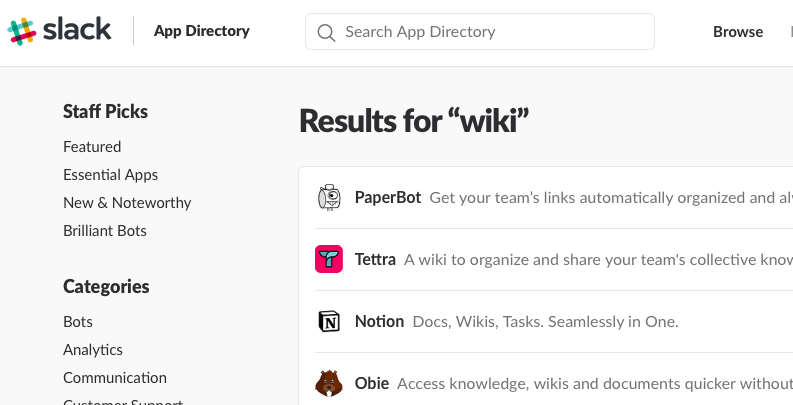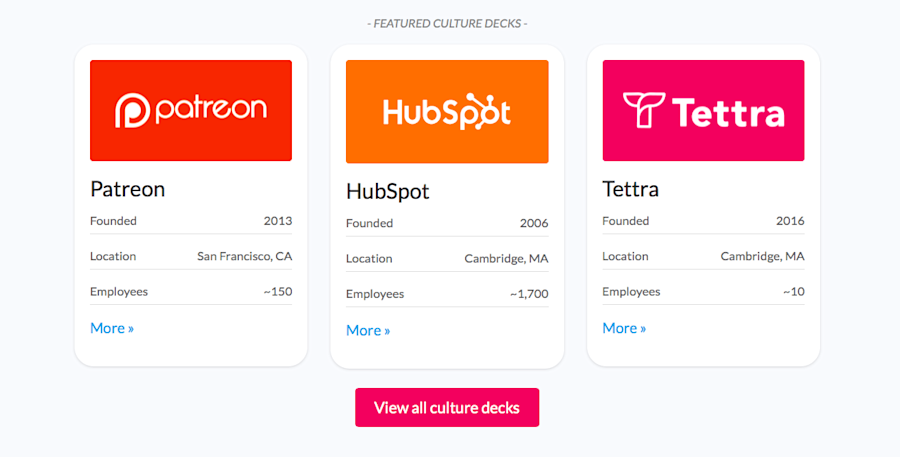Within months of founding their knowledgebase startup in 2015, Tettra co-founders Nelson Joyce and Andy Cook doubled down where they found traction: as a Slack integration tool.
Tettra, which currently markets itself as a wiki for Slack users, is built on top of Slack’s API.
They knew the risks.
Andy wrote about the advantages and disadvantages of building their product on another company’s platform in a guest post for Thinkgrowth.
“The platform can clone your entire product,” Andy warned. What happens if the platform decides to build your services into its native app? Why would people choose to continue using a third-party solution?
Here are other perils and perks Andy and Nelson considered:

Despite the risks, Andy and Nelson decided to build their product on Slack, and within two years, they were generating $25,000 in monthly recurring revenue (MRR).
Are you weighing the decision whether to connect your new startup to an already successful platform — like Slack or Salesforce?
Or do you have an integration you’re looking to promote?
In this article, we’ll look at why Nelson and Andy chose to develop and brand their startup around Slack instead of building from scratch; the step-by-step marketing strategy they used to become profitable; and how they’re expanding their brand to be more than just a Slack integration tool.
Note: Promoting a new startup or product? See which companies are showing interest by visiting your site using Leadfeeder. Try it free in minutes.
What Led to Tettra and Their Integration with Slack
Back in 2015, Nelson and Andy were leading a new project for HubSpot that eventually became the company’s first free marketing platform.
Their team was growing rapidly — from two to seven teammates in close to a month — and they were looking for something like Tettra. “We had all this knowledge basically trapped in our heads, and when we brought those five other people on, we didn’t have a good way to kind of share that stuff with them,” Nelson explained in a recent phone interview with us.
The existing systems were overly complex, clunky, and based on the Wikipedia model requiring users to learn a markup language. Nelson and Andy wanted something that was simpler, designed to keep information up-to-date, and to easily integrate with other tools.
They couldn’t find an application like this, so they left HubSpot to build a better knowledgebase tool.
They spent weeks doing customer interviews and mockups. When people seemed excited about the idea, they thought were onto something. They built a minimal viable product.
And no one used it.
“When we reached back out to those team to figure out what had happened, we found that they all still had a problem sharing internal knowledge. They still believed they could use Tettra to solve it. The problem was that no one remembered to use the product,” Andy explained.
Around that time, Slack launched its app directory, and Nelson and Andy thought back on all of those customer interviews they’d done. Every one of them mentioned that they loved Slack.
So they built an integration. They were one of the first 50 tools listed in Slack’s app directory.

“Immediately we had hundreds of people sign up. There was this huge interest in and demand for basically a Wiki for Slack,” Nelson said. “There was obviously validation here for our business.”
At this point, they rebuilt their product to be optimized for Slack and focused their attention on growing their startup around the existing platform.
What follows is the step-by-step process Tettra used to build their startup:
1. They Used the Platform to Launch Quickly and Charged from Day One
Tettra charged from day one. When potential users signed up for a trial, they required interested parties to sign up for a live demo to gain access to the software.
This allowed the team to ask prospects what they were looking for. They launched in the spring of 2016 and had their first paying user by that May.
2. They Used Interest from Slack Users to Attract Investors
For about six months, Nelson and Andy had been bootstrapping development. With the new interest of the Slack users, they were able to show proof of traction and raise $940,000 from angel investors.
“We wanted to build a company where we didn’t have to raise money. We only raised money when we wanted to raise money. You want to use fundraising money as a fuel, but not oxygen. You don’t want it to be alive; you just want it to make your fire burn brighter.”
Many of their investors were connected to HubSpot, but Nelson explained that being former employees did not guarantee any investment. “It wasn’t easy. We needed a lot of traction, and even with the traction and the relationship, it still wasn’t a sure thing.”
It helped that HubSpot executives knew Nelson and Andy’s ability to both build a product and manage a team, but what really sold them was the amount of people signing up for trials.
Note: Want to build traction? See which companies are showing interest by visiting your site using Leadfeeder. Try it free in minutes.
3. They Optimized Their Site Based on the Platform’s Best-Performing Keywords
At first, the Slack app directory was their only acquisition channel, and then they noticed they were ranking well for “slack Wiki” Google searches. It wasn’t yet a popular search, but they believed it would become more popular and wanted to get on top of that wave.
“So we invested in optimizing the site for that keyword: Slack Wiki or Wiki for Slack. I don’t know exactly when, but Google ended up surpassing the Slack directory for wiki related terms,” Nelson said.
Between their SEO traffic and the Slack directory, they were getting hundreds of trial sign-ups a month.
4. They Focused on What They Knew Best for Client Acquisitions
Nelson and Andy tried a bunch of marketing strategies, including PR announcements, maintaining listings in many app directories, running paid ads on Facebook, and several others, but their two main sources of clients are their organic traffic and the Slack app directory.
“We never really could get paid to work. And it seems like one of those things where you just have to turn it on. But it’s a very specific skill, and you need to be good at it, and you have to work at it and iterate on it for long periods of time. We just didn’t have the skill or time for it.”
This follows the Bullseye Framework the partners used, trying different marketing strategies, and then narrowing their focus to the one or two strategies that work the best.
“You just go through cycles of divergent and convergent thinking. Because if you get too complacent on one or two things, you’re probably going to get steamrolled eventually. It’s hard to balance the risk of all your eggs in one basket versus focus.”
Nelson explained that most successful startups he knows follow the power rule. The majority of their customers come from one to two acquisition channels. You could eliminate the rest, and your company would still grow.
“It’s just about doubling down on things that work while always testing other things and basically being paranoid that something else is going to come around that you’re going to miss the boat on.”
5. Nelson’s Secret Hack for Ranking in App Directories
App directories can be a slow trickle funnel strategy unless you get lucky or can take Nelson’s unusual advice for ranking in the directory: Make friends with the people who run them.
“It’s crazy, but that is literally how it works. If someone knows your name, they’re going to be like, ‘Oh let’s put her on the front of the app directory.’”

6. They Separate SEO and Brand Building for Content Marketing
Tettra maintains an SEO-driven blog at tetra.co/knowledge-management to drive traffic through their funnel.
Since they were ranking for Slack wiki, they did a test to see if they could rank for other keywords. They started with things like “alternatives to Sharepoint.” Andy wrote three blog posts in one month and then sat back and “let them marinate.”
“We were ranking and getting trials from this. If we spend more time, we’ll just get more trials. That’s a scalable thing.”
They hired someone to continue writing keyword optimized posts and have found consistent growth from their work.
In addition, they maintain a separate Medium blog with company and product updates, as well as insights around running a startup. Since Medium maintains active startup and small business communities, this blog reaches new users and helps with brand recognition while keeping their main URL optimized for funnel-driven traffic.
“I have a design background and, to me, clarity of message throughout the funnel is super important. Presenting too many things to people at once has a ton of cognitive load like, ‘What am I looking at here? I’m reading a story about these two entrepreneurs, but you’re showing me knowledge management articles. What does this have to do with each other?’ I like to keep things separate,” Nelson explained.
7. Take Risks to Build Brand
While Tettra practices a bullseye strategy for obtaining clients, when it comes to branding, they’re willing to spend more time and energy on experimenting.
In addition to their two blogs, Tettra also maintains a microsite called Culture Codes which includes blog posts and a podcast featuring interviews with startup leaders. You’ll also find a directory of employee handbooks and culture decks on how other companies are running their operations.

“The whole point is to build a brand around the topic of organizational design. It’s not driving a ton of trials directly but, even though we can’t measure it week-to-week, month-to-month, we think that investing in branding is going to be a differentiator down the road.”
Nelson admits they spend a lot of time and energy on this project, all of which is a bet to take advantage of an arbitrage opportunity.
“Things that are hard to measure, people are going to be less likely to do, so there’s going to be less competition. None of our competitors are doing this, probably because you can’t measure it, and you can’t put it in the bullseye framework.”
Tettra maintains multiple funnels that catch people with different interests. “A person searching for knowledge management content is such a different person than one who might come across NASA’s culture deck. And it’s different than a person who cares personally about our personal journeys.”
Why They’re Not Worried About Being Pigeon-Holed
Brand-driven projects like Culture Codes can help companies whose brand revolves around an existing platform begin to build an identity apart from it. This is one of the reasons why Tettra’s founders don’t feel stuck as a Slack-centric company. They know it’s possible to expand beyond that identity.
“We’re actively trying to move toward Slack as an integration instead of the core value of our product. Instead of a wiki for Slack or a wiki that connects to Slack, we want to be a wiki that connects to anything.”
There are two ways to grow, horizontally or vertically, and Tettra hasn’t decided which way will work best for them. Horizontal growth would look like connecting to all chat tools similar to Slack and be a “chat-enabled wiki.”
Vertical growth would entail building features to best integrate with a related market, such as project management or engineering tools — especially ones already used by Slack users. They see advantages and disadvantages of both approaches.
“You have to get escape velocity and get out of the orbit. You have to go from being a satellite around the planet Slack, to your own moon, then your own planet. Basically, you have to keep getting bigger and bigger so that you can escape that gravity.”
Now that you're here
Leadfeeder is a tool that shows you companies that visit your website. Leadfeeder generates new leads, offers insight on your customers and can help you increase your marketing ROI.
If you liked this blog post, you'll probably love Leadfeeder, too.
Sign up



